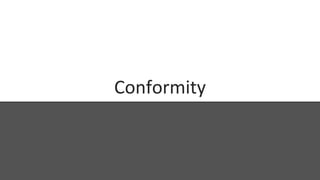
Group Pressures and Conformity: Types, Experiments, and Factors
- 1. Conformity
- 2. What is Conformity? • Conformity is simply “yielding to group pressures”. There are many different forms of conformity. • Examples • A man in a crowd disagrees with the crowd, but to avoid persecution, agrees with the crowd when asked. • Someone does not know the answer to a question, so ends up saying what the rest of the crowd says due to lack of knowledge. • A student changing their clothing to fit what is expected of them by society at a school dance.
- 3. Types of Conformity • Normative Conformity – Yielding to group pressure just to fit in with the group. • Informational Conformity – Lack of knowledge leads someone to agree with the group. • Compliance – Publicly changing behavior to fit in, but privately disagreeing. • Internalization – Publicly changing behavior to fit in, and also agreeing privately. • Ingratiational Conformity – Conforming to impress or gain acceptance from others. • Identification – Conforming to a social role.
- 4. Experiments regarding Conformity. • Solomon Asch’s line experiment involving 50 male students from Swarthmore College in a vision test. Students were tested on the length of a line relative to another line. Participants had confederates around them who intentionally gave wrong answers to see if the participant would agree with them. • The Sherif Autokinetic Effect Experiment took place in 1935 and tested whether people will conform when in an ambiguous situation. A small spot of light moves in a dark room even though it is not moving. The person with an estimate greatly different than others usually ended up conforming to the rest of the group.
- 5. Factors in Conforming • The difficulty of a task – Being unable to perform a difficult task can decrease conformity due to lack of knowledge, or increase conformity if having multiple solutions is what the problem requires. • Individual differences – Motivation and ability to lead can decrease tendency to conform. • Size of the group – The larger the group, the easier it is to conform, while if there are less then conforming is harder. • Characteristics of situation – People conform in ambiguous situations that they do not know how to respond to. • Cultural differences - Cultures that are more interdependent (East Asian cultures) tend to conform more than individualist cultures (United States).